Community-Based Obesity Prevention Action Plan: Australia Report
VerifiedAdded on 2022/10/11
|11
|2065
|18
Report
AI Summary
This report presents an obesity prevention action plan designed for the Australian context, specifically targeting the adolescent population of Aboriginal and Torres Strait Islander communities, who are disproportionately affected by obesity. The plan emphasizes community engagement, highlighting the crucial role of various partners including legal policies, community members, organizations like the Australian and New Zealand Obesity Society, family members, and the adolescents themselves. Strategies for engaging these partners include educational empowerment, awareness programs, nutrition initiatives, and job opportunities. The program's goal is to reduce obesity prevalence and promote healthy lifestyles through school policy modifications, social media campaigns, and training sessions. The report details a SMART objective, best practice principles, program design, and evaluation methods, including vending machine audits, surveys, questionnaires, and social media analytics. The report also addresses sustainability and governance, suggesting policies and funding mechanisms to ensure the program's long-term success, involving government departments and key stakeholders like the Department of Human Services and school principals.
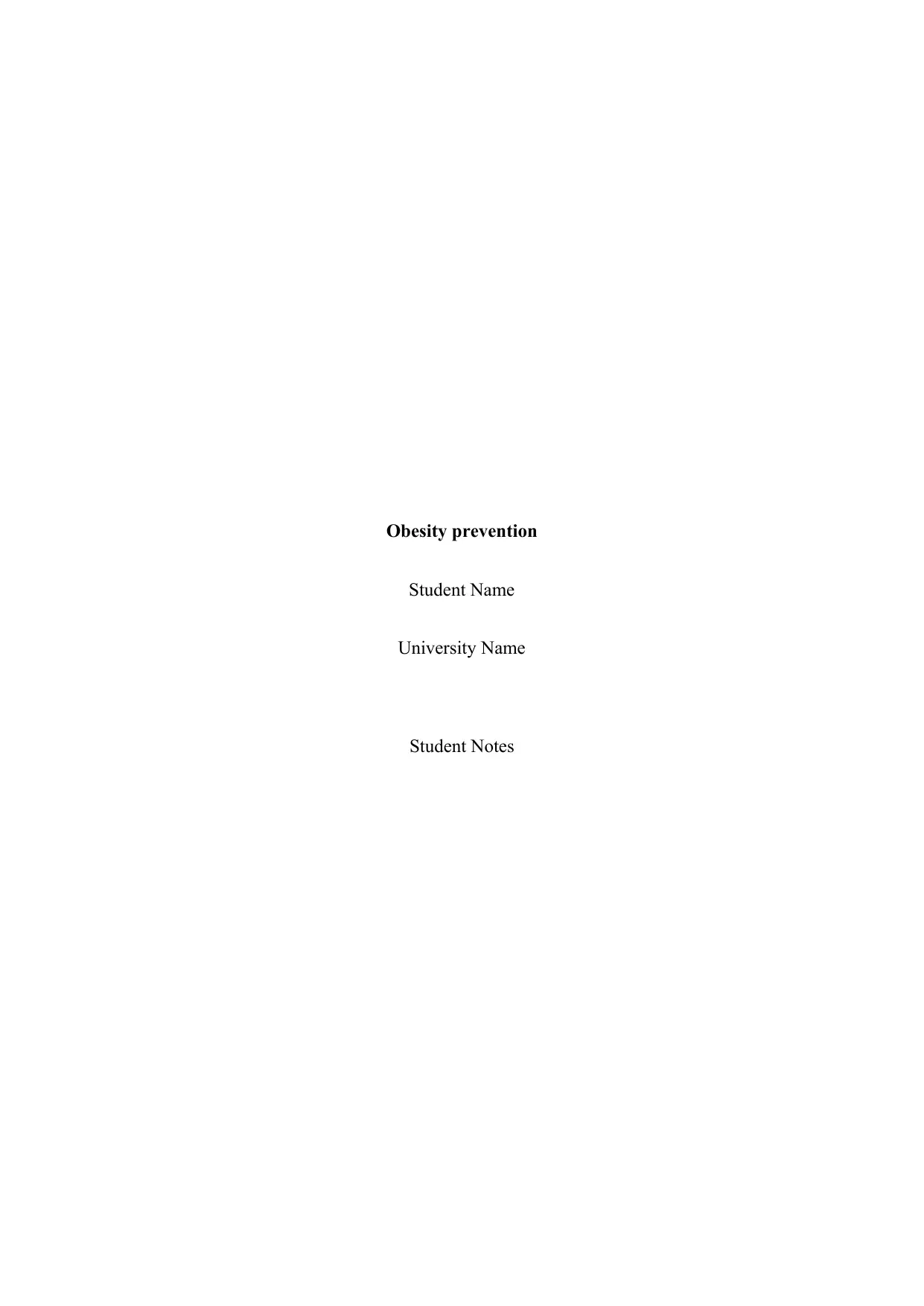
Obesity prevention
Student Name
University Name
Student Notes
Student Name
University Name
Student Notes
Paraphrase This Document
Need a fresh take? Get an instant paraphrase of this document with our AI Paraphraser
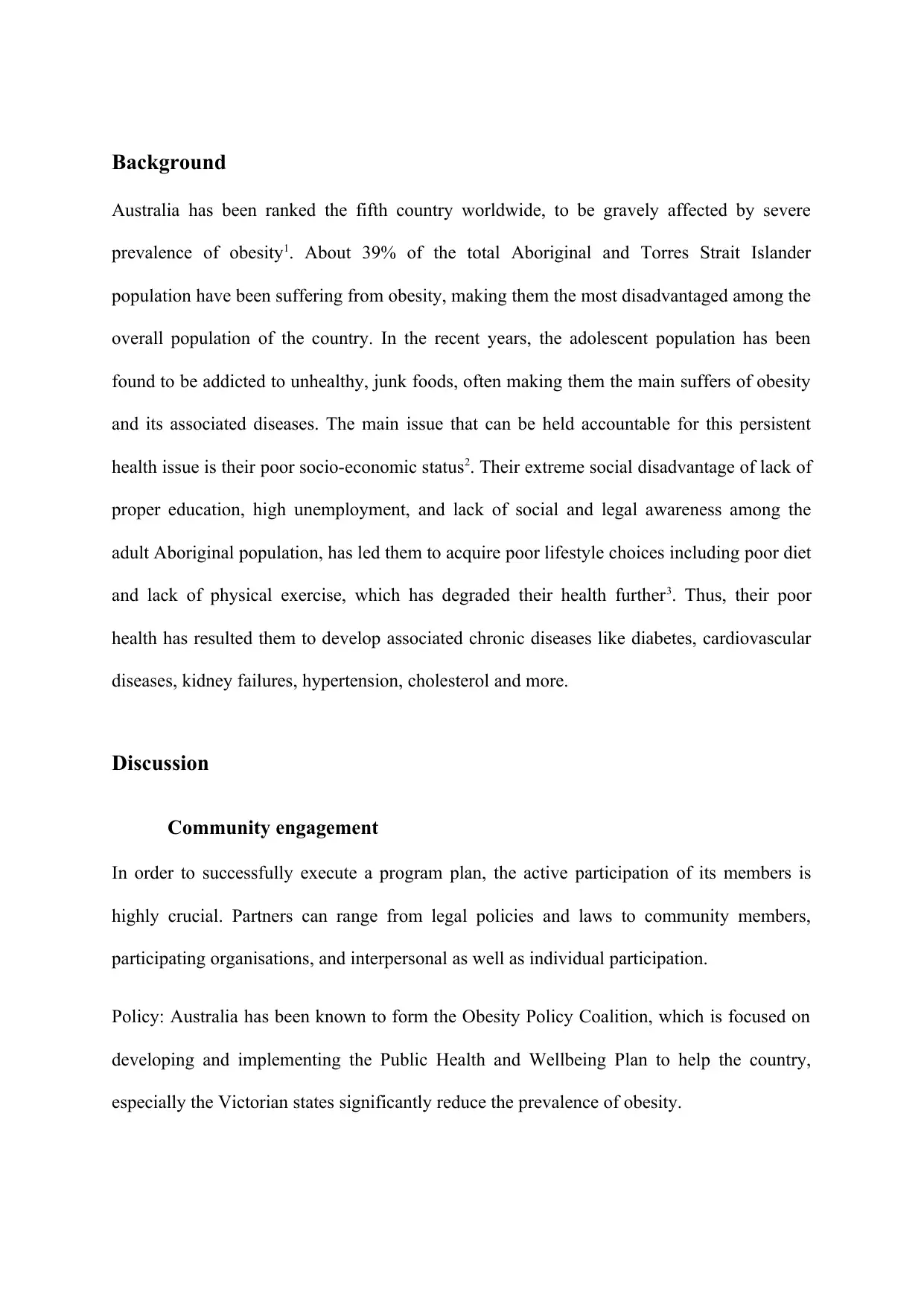
Background
Australia has been ranked the fifth country worldwide, to be gravely affected by severe
prevalence of obesity1. About 39% of the total Aboriginal and Torres Strait Islander
population have been suffering from obesity, making them the most disadvantaged among the
overall population of the country. In the recent years, the adolescent population has been
found to be addicted to unhealthy, junk foods, often making them the main suffers of obesity
and its associated diseases. The main issue that can be held accountable for this persistent
health issue is their poor socio-economic status2. Their extreme social disadvantage of lack of
proper education, high unemployment, and lack of social and legal awareness among the
adult Aboriginal population, has led them to acquire poor lifestyle choices including poor diet
and lack of physical exercise, which has degraded their health further3. Thus, their poor
health has resulted them to develop associated chronic diseases like diabetes, cardiovascular
diseases, kidney failures, hypertension, cholesterol and more.
Discussion
Community engagement
In order to successfully execute a program plan, the active participation of its members is
highly crucial. Partners can range from legal policies and laws to community members,
participating organisations, and interpersonal as well as individual participation.
Policy: Australia has been known to form the Obesity Policy Coalition, which is focused on
developing and implementing the Public Health and Wellbeing Plan to help the country,
especially the Victorian states significantly reduce the prevalence of obesity.
Australia has been ranked the fifth country worldwide, to be gravely affected by severe
prevalence of obesity1. About 39% of the total Aboriginal and Torres Strait Islander
population have been suffering from obesity, making them the most disadvantaged among the
overall population of the country. In the recent years, the adolescent population has been
found to be addicted to unhealthy, junk foods, often making them the main suffers of obesity
and its associated diseases. The main issue that can be held accountable for this persistent
health issue is their poor socio-economic status2. Their extreme social disadvantage of lack of
proper education, high unemployment, and lack of social and legal awareness among the
adult Aboriginal population, has led them to acquire poor lifestyle choices including poor diet
and lack of physical exercise, which has degraded their health further3. Thus, their poor
health has resulted them to develop associated chronic diseases like diabetes, cardiovascular
diseases, kidney failures, hypertension, cholesterol and more.
Discussion
Community engagement
In order to successfully execute a program plan, the active participation of its members is
highly crucial. Partners can range from legal policies and laws to community members,
participating organisations, and interpersonal as well as individual participation.
Policy: Australia has been known to form the Obesity Policy Coalition, which is focused on
developing and implementing the Public Health and Wellbeing Plan to help the country,
especially the Victorian states significantly reduce the prevalence of obesity.

Community: In order to help the indigenous population of the country, active participation of
the Aboriginal and Torres Strait Islander is highly crucial. Before devising of any plan or
program, the consent or acknowledgement of the target population or community is
extremely necessary for the evaluating the success of the program.
Organisation: Public Health Advocacy Institute of Western Australia and the Australian and
New Zealand Obesity Society are some of the organisations which have been focusing on the
issue of obesity among the Aboriginal population. In order to successfully execute the action
plan, it is highly crucial for these members to fund or help organise the associated programs
that will help increase the impact of the plan on the target population.
Interpersonal: Participation of family members and friends is very crucial when it comes to
the adolescent population, as they can help in providing mental support to those suffering
from obesity. They can also expedite the process of helping the target population overcome
the different associated health issues of obesity.
Individual: The participation of the adolescent Aboriginals suffering from obesity will ensure
the increased success of the program. The program can help teach the obese Aboriginal
population of Australia health awareness, self-management strategies and prevent the
occurrence of associated diseases.
Strategies which can be employed by the program to help attract and engage these partners
are as follows:
Educational empowerment of the Aboriginals through seminars and workshops
Organising awareness programs and setting up counselling camps to help the
Aboriginals seek help.
Nutrition programs for the target population4.
the Aboriginal and Torres Strait Islander is highly crucial. Before devising of any plan or
program, the consent or acknowledgement of the target population or community is
extremely necessary for the evaluating the success of the program.
Organisation: Public Health Advocacy Institute of Western Australia and the Australian and
New Zealand Obesity Society are some of the organisations which have been focusing on the
issue of obesity among the Aboriginal population. In order to successfully execute the action
plan, it is highly crucial for these members to fund or help organise the associated programs
that will help increase the impact of the plan on the target population.
Interpersonal: Participation of family members and friends is very crucial when it comes to
the adolescent population, as they can help in providing mental support to those suffering
from obesity. They can also expedite the process of helping the target population overcome
the different associated health issues of obesity.
Individual: The participation of the adolescent Aboriginals suffering from obesity will ensure
the increased success of the program. The program can help teach the obese Aboriginal
population of Australia health awareness, self-management strategies and prevent the
occurrence of associated diseases.
Strategies which can be employed by the program to help attract and engage these partners
are as follows:
Educational empowerment of the Aboriginals through seminars and workshops
Organising awareness programs and setting up counselling camps to help the
Aboriginals seek help.
Nutrition programs for the target population4.
⊘ This is a preview!⊘
Do you want full access?
Subscribe today to unlock all pages.

Trusted by 1+ million students worldwide
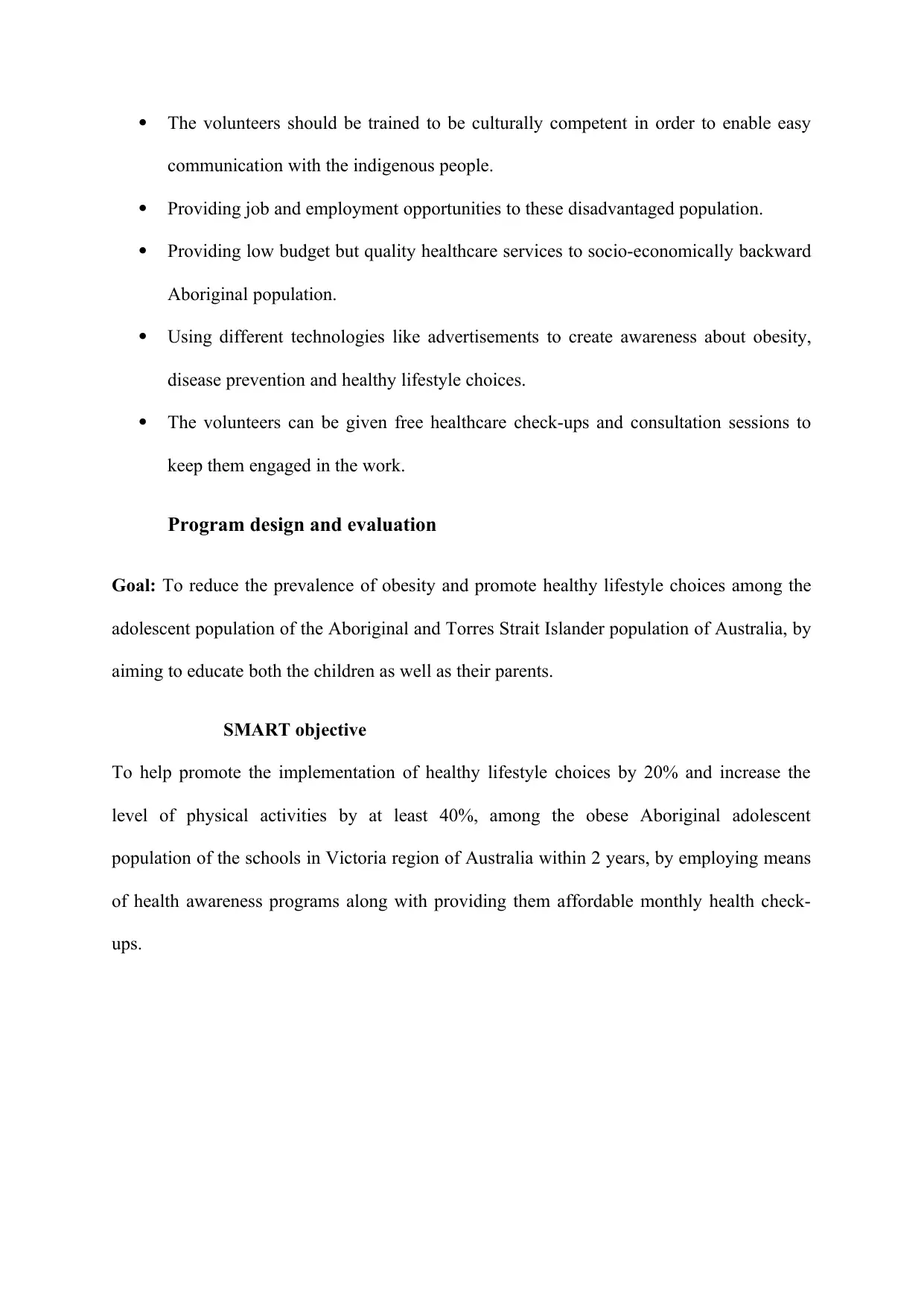
The volunteers should be trained to be culturally competent in order to enable easy
communication with the indigenous people.
Providing job and employment opportunities to these disadvantaged population.
Providing low budget but quality healthcare services to socio-economically backward
Aboriginal population.
Using different technologies like advertisements to create awareness about obesity,
disease prevention and healthy lifestyle choices.
The volunteers can be given free healthcare check-ups and consultation sessions to
keep them engaged in the work.
Program design and evaluation
Goal: To reduce the prevalence of obesity and promote healthy lifestyle choices among the
adolescent population of the Aboriginal and Torres Strait Islander population of Australia, by
aiming to educate both the children as well as their parents.
SMART objective
To help promote the implementation of healthy lifestyle choices by 20% and increase the
level of physical activities by at least 40%, among the obese Aboriginal adolescent
population of the schools in Victoria region of Australia within 2 years, by employing means
of health awareness programs along with providing them affordable monthly health check-
ups.
communication with the indigenous people.
Providing job and employment opportunities to these disadvantaged population.
Providing low budget but quality healthcare services to socio-economically backward
Aboriginal population.
Using different technologies like advertisements to create awareness about obesity,
disease prevention and healthy lifestyle choices.
The volunteers can be given free healthcare check-ups and consultation sessions to
keep them engaged in the work.
Program design and evaluation
Goal: To reduce the prevalence of obesity and promote healthy lifestyle choices among the
adolescent population of the Aboriginal and Torres Strait Islander population of Australia, by
aiming to educate both the children as well as their parents.
SMART objective
To help promote the implementation of healthy lifestyle choices by 20% and increase the
level of physical activities by at least 40%, among the obese Aboriginal adolescent
population of the schools in Victoria region of Australia within 2 years, by employing means
of health awareness programs along with providing them affordable monthly health check-
ups.
Paraphrase This Document
Need a fresh take? Get an instant paraphrase of this document with our AI Paraphraser
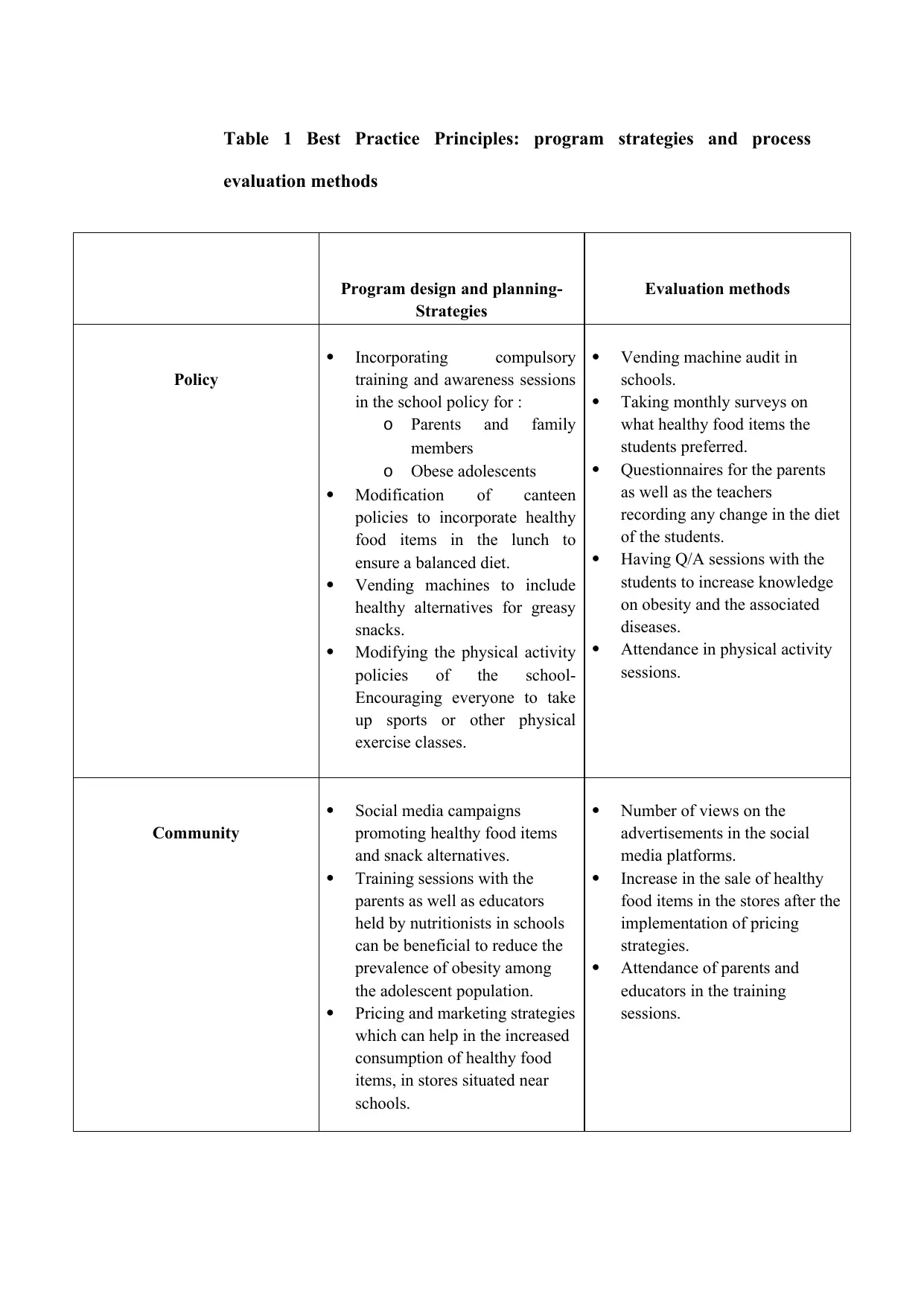
Table 1 Best Practice Principles: program strategies and process
evaluation methods
Program design and planning-
Strategies
Evaluation methods
Policy
Incorporating compulsory
training and awareness sessions
in the school policy for :
o Parents and family
members
o Obese adolescents
Modification of canteen
policies to incorporate healthy
food items in the lunch to
ensure a balanced diet.
Vending machines to include
healthy alternatives for greasy
snacks.
Modifying the physical activity
policies of the school-
Encouraging everyone to take
up sports or other physical
exercise classes.
Vending machine audit in
schools.
Taking monthly surveys on
what healthy food items the
students preferred.
Questionnaires for the parents
as well as the teachers
recording any change in the diet
of the students.
Having Q/A sessions with the
students to increase knowledge
on obesity and the associated
diseases.
Attendance in physical activity
sessions.
Community
Social media campaigns
promoting healthy food items
and snack alternatives.
Training sessions with the
parents as well as educators
held by nutritionists in schools
can be beneficial to reduce the
prevalence of obesity among
the adolescent population.
Pricing and marketing strategies
which can help in the increased
consumption of healthy food
items, in stores situated near
schools.
Number of views on the
advertisements in the social
media platforms.
Increase in the sale of healthy
food items in the stores after the
implementation of pricing
strategies.
Attendance of parents and
educators in the training
sessions.
evaluation methods
Program design and planning-
Strategies
Evaluation methods
Policy
Incorporating compulsory
training and awareness sessions
in the school policy for :
o Parents and family
members
o Obese adolescents
Modification of canteen
policies to incorporate healthy
food items in the lunch to
ensure a balanced diet.
Vending machines to include
healthy alternatives for greasy
snacks.
Modifying the physical activity
policies of the school-
Encouraging everyone to take
up sports or other physical
exercise classes.
Vending machine audit in
schools.
Taking monthly surveys on
what healthy food items the
students preferred.
Questionnaires for the parents
as well as the teachers
recording any change in the diet
of the students.
Having Q/A sessions with the
students to increase knowledge
on obesity and the associated
diseases.
Attendance in physical activity
sessions.
Community
Social media campaigns
promoting healthy food items
and snack alternatives.
Training sessions with the
parents as well as educators
held by nutritionists in schools
can be beneficial to reduce the
prevalence of obesity among
the adolescent population.
Pricing and marketing strategies
which can help in the increased
consumption of healthy food
items, in stores situated near
schools.
Number of views on the
advertisements in the social
media platforms.
Increase in the sale of healthy
food items in the stores after the
implementation of pricing
strategies.
Attendance of parents and
educators in the training
sessions.
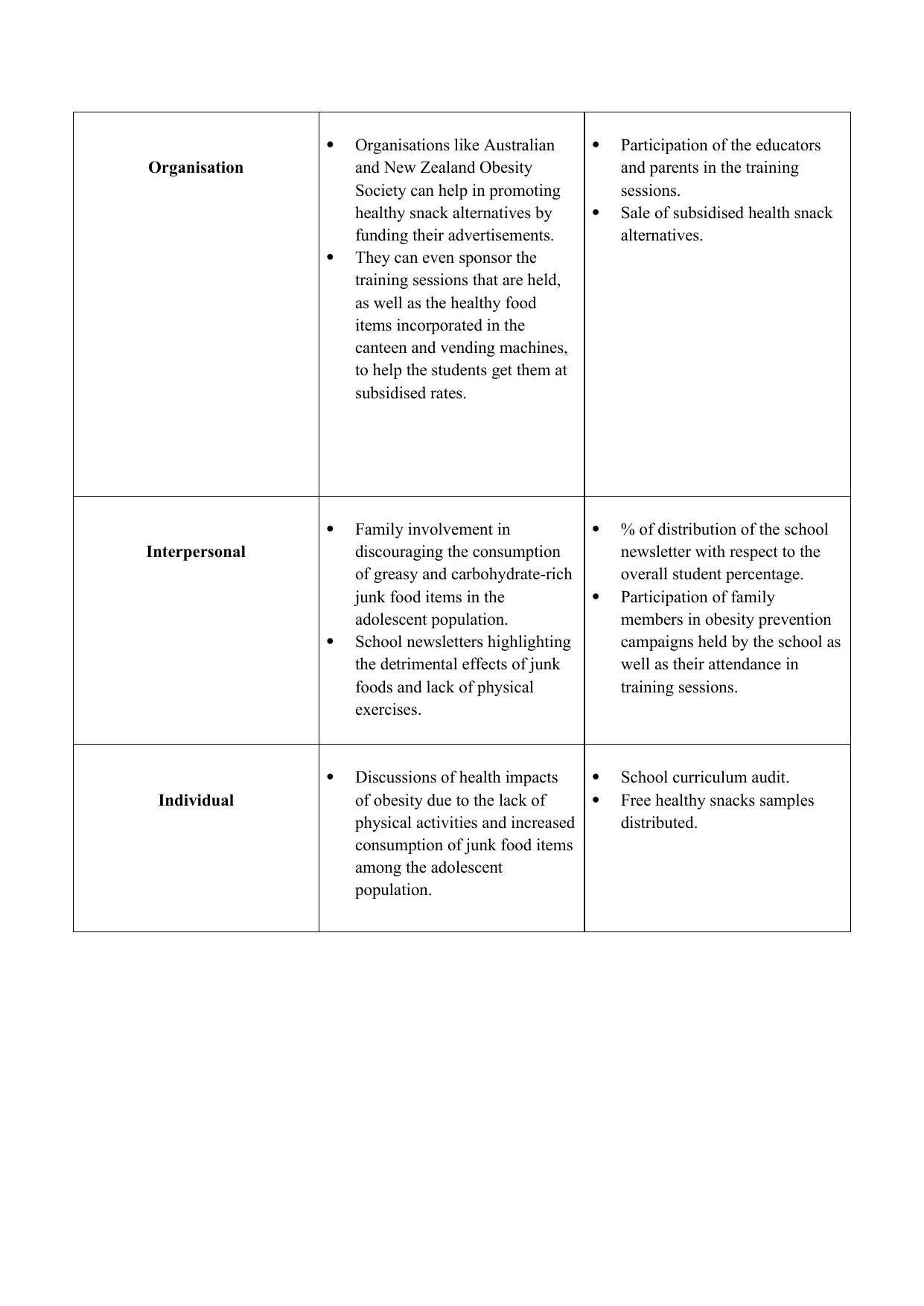
Organisation
Organisations like Australian
and New Zealand Obesity
Society can help in promoting
healthy snack alternatives by
funding their advertisements.
They can even sponsor the
training sessions that are held,
as well as the healthy food
items incorporated in the
canteen and vending machines,
to help the students get them at
subsidised rates.
Participation of the educators
and parents in the training
sessions.
Sale of subsidised health snack
alternatives.
Interpersonal
Family involvement in
discouraging the consumption
of greasy and carbohydrate-rich
junk food items in the
adolescent population.
School newsletters highlighting
the detrimental effects of junk
foods and lack of physical
exercises.
% of distribution of the school
newsletter with respect to the
overall student percentage.
Participation of family
members in obesity prevention
campaigns held by the school as
well as their attendance in
training sessions.
Individual
Discussions of health impacts
of obesity due to the lack of
physical activities and increased
consumption of junk food items
among the adolescent
population.
School curriculum audit.
Free healthy snacks samples
distributed.
Organisations like Australian
and New Zealand Obesity
Society can help in promoting
healthy snack alternatives by
funding their advertisements.
They can even sponsor the
training sessions that are held,
as well as the healthy food
items incorporated in the
canteen and vending machines,
to help the students get them at
subsidised rates.
Participation of the educators
and parents in the training
sessions.
Sale of subsidised health snack
alternatives.
Interpersonal
Family involvement in
discouraging the consumption
of greasy and carbohydrate-rich
junk food items in the
adolescent population.
School newsletters highlighting
the detrimental effects of junk
foods and lack of physical
exercises.
% of distribution of the school
newsletter with respect to the
overall student percentage.
Participation of family
members in obesity prevention
campaigns held by the school as
well as their attendance in
training sessions.
Individual
Discussions of health impacts
of obesity due to the lack of
physical activities and increased
consumption of junk food items
among the adolescent
population.
School curriculum audit.
Free healthy snacks samples
distributed.
⊘ This is a preview!⊘
Do you want full access?
Subscribe today to unlock all pages.

Trusted by 1+ million students worldwide
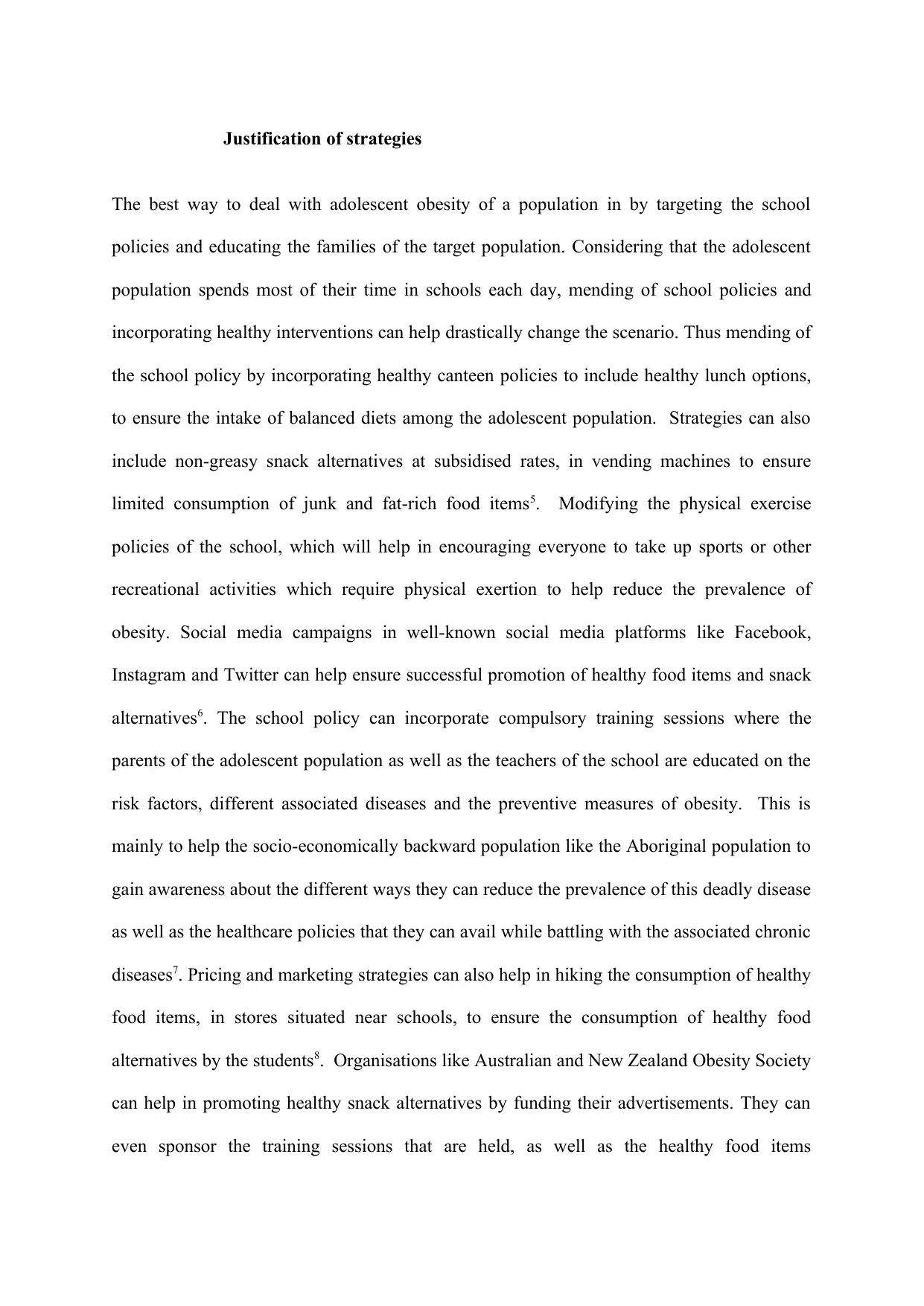
Justification of strategies
The best way to deal with adolescent obesity of a population in by targeting the school
policies and educating the families of the target population. Considering that the adolescent
population spends most of their time in schools each day, mending of school policies and
incorporating healthy interventions can help drastically change the scenario. Thus mending of
the school policy by incorporating healthy canteen policies to include healthy lunch options,
to ensure the intake of balanced diets among the adolescent population. Strategies can also
include non-greasy snack alternatives at subsidised rates, in vending machines to ensure
limited consumption of junk and fat-rich food items5. Modifying the physical exercise
policies of the school, which will help in encouraging everyone to take up sports or other
recreational activities which require physical exertion to help reduce the prevalence of
obesity. Social media campaigns in well-known social media platforms like Facebook,
Instagram and Twitter can help ensure successful promotion of healthy food items and snack
alternatives6. The school policy can incorporate compulsory training sessions where the
parents of the adolescent population as well as the teachers of the school are educated on the
risk factors, different associated diseases and the preventive measures of obesity. This is
mainly to help the socio-economically backward population like the Aboriginal population to
gain awareness about the different ways they can reduce the prevalence of this deadly disease
as well as the healthcare policies that they can avail while battling with the associated chronic
diseases7. Pricing and marketing strategies can also help in hiking the consumption of healthy
food items, in stores situated near schools, to ensure the consumption of healthy food
alternatives by the students8. Organisations like Australian and New Zealand Obesity Society
can help in promoting healthy snack alternatives by funding their advertisements. They can
even sponsor the training sessions that are held, as well as the healthy food items
The best way to deal with adolescent obesity of a population in by targeting the school
policies and educating the families of the target population. Considering that the adolescent
population spends most of their time in schools each day, mending of school policies and
incorporating healthy interventions can help drastically change the scenario. Thus mending of
the school policy by incorporating healthy canteen policies to include healthy lunch options,
to ensure the intake of balanced diets among the adolescent population. Strategies can also
include non-greasy snack alternatives at subsidised rates, in vending machines to ensure
limited consumption of junk and fat-rich food items5. Modifying the physical exercise
policies of the school, which will help in encouraging everyone to take up sports or other
recreational activities which require physical exertion to help reduce the prevalence of
obesity. Social media campaigns in well-known social media platforms like Facebook,
Instagram and Twitter can help ensure successful promotion of healthy food items and snack
alternatives6. The school policy can incorporate compulsory training sessions where the
parents of the adolescent population as well as the teachers of the school are educated on the
risk factors, different associated diseases and the preventive measures of obesity. This is
mainly to help the socio-economically backward population like the Aboriginal population to
gain awareness about the different ways they can reduce the prevalence of this deadly disease
as well as the healthcare policies that they can avail while battling with the associated chronic
diseases7. Pricing and marketing strategies can also help in hiking the consumption of healthy
food items, in stores situated near schools, to ensure the consumption of healthy food
alternatives by the students8. Organisations like Australian and New Zealand Obesity Society
can help in promoting healthy snack alternatives by funding their advertisements. They can
even sponsor the training sessions that are held, as well as the healthy food items
Paraphrase This Document
Need a fresh take? Get an instant paraphrase of this document with our AI Paraphraser
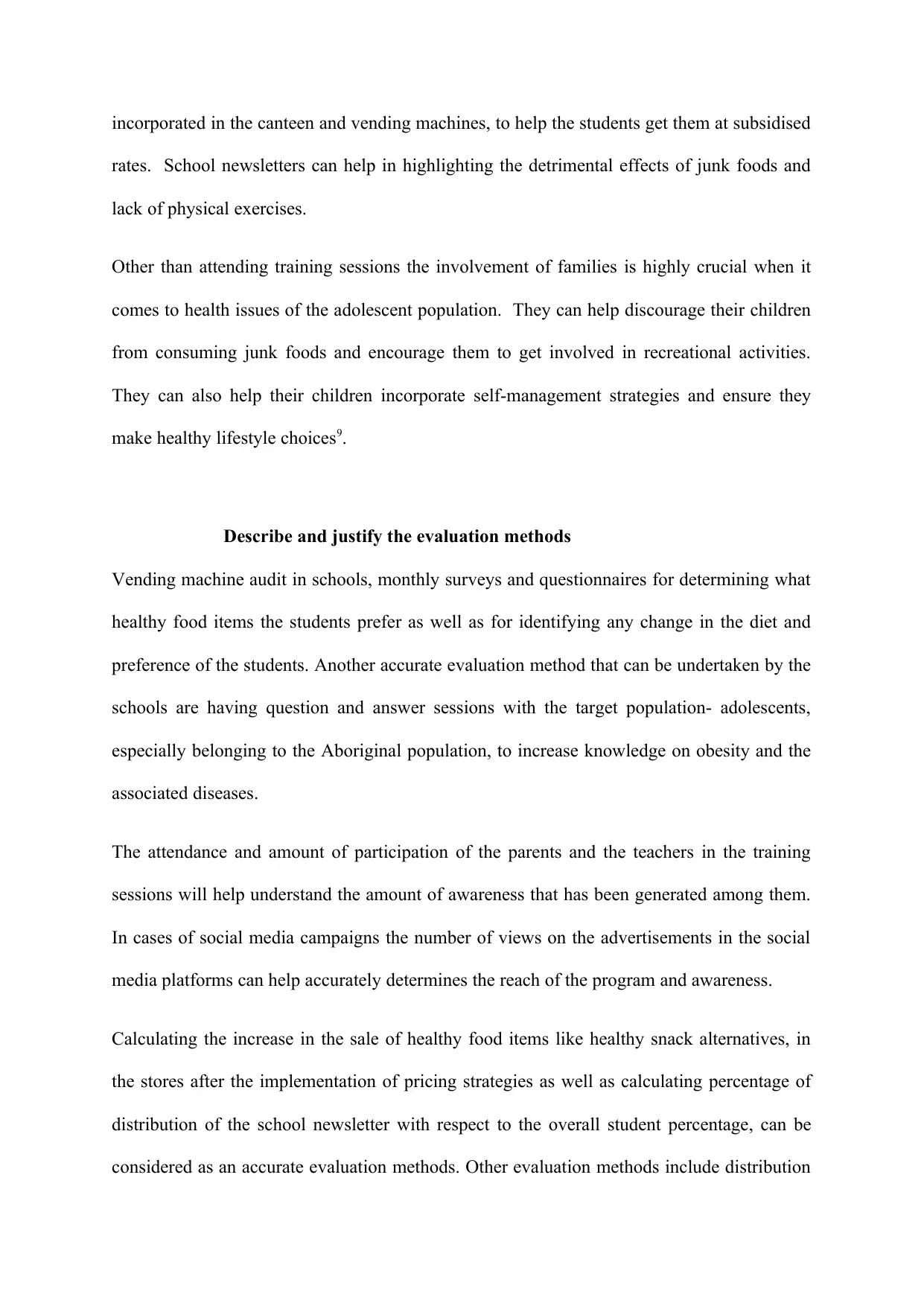
incorporated in the canteen and vending machines, to help the students get them at subsidised
rates. School newsletters can help in highlighting the detrimental effects of junk foods and
lack of physical exercises.
Other than attending training sessions the involvement of families is highly crucial when it
comes to health issues of the adolescent population. They can help discourage their children
from consuming junk foods and encourage them to get involved in recreational activities.
They can also help their children incorporate self-management strategies and ensure they
make healthy lifestyle choices9.
Describe and justify the evaluation methods
Vending machine audit in schools, monthly surveys and questionnaires for determining what
healthy food items the students prefer as well as for identifying any change in the diet and
preference of the students. Another accurate evaluation method that can be undertaken by the
schools are having question and answer sessions with the target population- adolescents,
especially belonging to the Aboriginal population, to increase knowledge on obesity and the
associated diseases.
The attendance and amount of participation of the parents and the teachers in the training
sessions will help understand the amount of awareness that has been generated among them.
In cases of social media campaigns the number of views on the advertisements in the social
media platforms can help accurately determines the reach of the program and awareness.
Calculating the increase in the sale of healthy food items like healthy snack alternatives, in
the stores after the implementation of pricing strategies as well as calculating percentage of
distribution of the school newsletter with respect to the overall student percentage, can be
considered as an accurate evaluation methods. Other evaluation methods include distribution
rates. School newsletters can help in highlighting the detrimental effects of junk foods and
lack of physical exercises.
Other than attending training sessions the involvement of families is highly crucial when it
comes to health issues of the adolescent population. They can help discourage their children
from consuming junk foods and encourage them to get involved in recreational activities.
They can also help their children incorporate self-management strategies and ensure they
make healthy lifestyle choices9.
Describe and justify the evaluation methods
Vending machine audit in schools, monthly surveys and questionnaires for determining what
healthy food items the students prefer as well as for identifying any change in the diet and
preference of the students. Another accurate evaluation method that can be undertaken by the
schools are having question and answer sessions with the target population- adolescents,
especially belonging to the Aboriginal population, to increase knowledge on obesity and the
associated diseases.
The attendance and amount of participation of the parents and the teachers in the training
sessions will help understand the amount of awareness that has been generated among them.
In cases of social media campaigns the number of views on the advertisements in the social
media platforms can help accurately determines the reach of the program and awareness.
Calculating the increase in the sale of healthy food items like healthy snack alternatives, in
the stores after the implementation of pricing strategies as well as calculating percentage of
distribution of the school newsletter with respect to the overall student percentage, can be
considered as an accurate evaluation methods. Other evaluation methods include distribution

of free healthy snack samples as well as the information revealed in the school curriculum
audit.
Sustainability and governance
Australian policies focusing on support and training for helping schools and organisations to
promote healthy foods consumption, as well as the policies of the Independent statutory
health promotion agencies can incorporate the discussed strategies to help ensure increased
awareness of obesity and their associated diseases affecting the Adolescent Aboriginal
population. The program can help ensure that the Federal government to regulate the
monitoring of BMI at the national level subsidised pricing on healthier snack alternatives and
reduced GST on fruits and vegetables10. The program can further encourage the health
department of the local government in Victoria to promote and fund the Independent
Statutory health promotion policy (VicHealth) to improve nutrition of the adolescent
population11. They can also sponsor advertisements which will ensure successful promotion
of health food items. They can also invest in promoting public education and improving
public awareness through education campaigns about diet related diseases12.
Gathering of funds and building rapport with the organisations and schools concerned with
the health of the children as well as funds from government departments can help in the
sustaining this program .Reference Committee includes the Department of Human Services,
as well as Department of Education and the principals from the schools situated in the
Victoria region of Australia. Project Management Group includes volunteers, Project
managers and coordinators as well as student Ambassadors Group includes students from
each school are also the governing bodies which will ensure sustainable development of the
program.
audit.
Sustainability and governance
Australian policies focusing on support and training for helping schools and organisations to
promote healthy foods consumption, as well as the policies of the Independent statutory
health promotion agencies can incorporate the discussed strategies to help ensure increased
awareness of obesity and their associated diseases affecting the Adolescent Aboriginal
population. The program can help ensure that the Federal government to regulate the
monitoring of BMI at the national level subsidised pricing on healthier snack alternatives and
reduced GST on fruits and vegetables10. The program can further encourage the health
department of the local government in Victoria to promote and fund the Independent
Statutory health promotion policy (VicHealth) to improve nutrition of the adolescent
population11. They can also sponsor advertisements which will ensure successful promotion
of health food items. They can also invest in promoting public education and improving
public awareness through education campaigns about diet related diseases12.
Gathering of funds and building rapport with the organisations and schools concerned with
the health of the children as well as funds from government departments can help in the
sustaining this program .Reference Committee includes the Department of Human Services,
as well as Department of Education and the principals from the schools situated in the
Victoria region of Australia. Project Management Group includes volunteers, Project
managers and coordinators as well as student Ambassadors Group includes students from
each school are also the governing bodies which will ensure sustainable development of the
program.
⊘ This is a preview!⊘
Do you want full access?
Subscribe today to unlock all pages.

Trusted by 1+ million students worldwide

References
Paraphrase This Document
Need a fresh take? Get an instant paraphrase of this document with our AI Paraphraser

1 Thorburn AW. Prevalence of obesity in Australia. Obesity Reviews. 2005 Aug;6(3):187-9.
2 Australian Indigenous HealthInfoNet. Social and Cultural Determinants - Determinants of health -
Australian Indigenous HealthInfoNet [Internet]. Australian Indigenous HealthInfoNet. 2019 [cited
28 September 2019]. Available from:
https://healthinfonet.ecu.edu.au/learn/determinants-of-health/social-cultural-determinants/
3 Azzopardi PS, Sawyer SM, Carlin JB, Degenhardt L, Brown N, Brown AD, Patton GC. Health
and wellbeing of Indigenous adolescents in Australia: a systematic synthesis of population data. The
Lancet. 2018 Feb 24;391(10122):766-82.
4 Browne J, Adams K, Atkinson P, Gleeson D, Hayes R. Food and nutrition programs for
Aboriginal and Torres Strait Islander Australians: An overview of systematic reviews. Australian
Health Review. 2018 Dec 19;42(6):689-97.
5 King L, Gill T, Allender S, Swinburn B. Best practice principles for community‐based obesity
prevention: development, content and application. Obesity reviews. 2011 May;12(5):329-38.
6 Jago R, McMurray RG, Bassin S, Pyle L, Bruecker S, Jakicic JM, Moe E, Murray T, Volpe SL.
Modifying middle school physical education: piloting strategies to increase physical activity.
Pediatric exercise science. 2009 May 1;21(2):171-85.
7 O’Dea K. Preventable chronic diseases among indigenous Australians: the need for a
comprehensive national approach. Heart, Lung and Circulation. 2005 Sep 1;14(3):167-71.
8 Rowley KG, Daniel M, Skinner K, Skinner M, White GA, O'Dea K. Effectiveness of a
community‐directed ‘healthy lifestyle’program in a remote Australian Aboriginal community.
Australian and New Zealand journal of public health. 2000 Apr;24(2):136-44.
9 fpnsw.org.au. Aboriginal [Internet]. Family Planning NSW. 2019 [cited 28 September 2019].
Available from: https://www.fpnsw.org.au/topics/aboriginal.
10 Kim S, Macaskill P, Baur LA, Hodson EM, Daylight J, Williams R, Kearns R, Vukasin N, Lyle
DM, Craig JC. The differential effect of socio-economic status, birth weight and gender on body
mass index in Australian Aboriginal Children. International Journal of Obesity. 2016
Jul;40(7):1089.
11 Heartfoundation.org.au. Policies for tackling obesity and creating healthier food environments
[Internet]. Heartfoundation.org.au. 2019 [cited 28 September 2019]. Available from:
https://www.heartfoundation.org.au/images/uploads/publications/OVERALL_Food_EPI_Report_v
3.pdf
12 Alsharairi N. Current government actions and potential policy options for reducing obesity in
Queensland schools. Children. 2018;5(2):18.
2 Australian Indigenous HealthInfoNet. Social and Cultural Determinants - Determinants of health -
Australian Indigenous HealthInfoNet [Internet]. Australian Indigenous HealthInfoNet. 2019 [cited
28 September 2019]. Available from:
https://healthinfonet.ecu.edu.au/learn/determinants-of-health/social-cultural-determinants/
3 Azzopardi PS, Sawyer SM, Carlin JB, Degenhardt L, Brown N, Brown AD, Patton GC. Health
and wellbeing of Indigenous adolescents in Australia: a systematic synthesis of population data. The
Lancet. 2018 Feb 24;391(10122):766-82.
4 Browne J, Adams K, Atkinson P, Gleeson D, Hayes R. Food and nutrition programs for
Aboriginal and Torres Strait Islander Australians: An overview of systematic reviews. Australian
Health Review. 2018 Dec 19;42(6):689-97.
5 King L, Gill T, Allender S, Swinburn B. Best practice principles for community‐based obesity
prevention: development, content and application. Obesity reviews. 2011 May;12(5):329-38.
6 Jago R, McMurray RG, Bassin S, Pyle L, Bruecker S, Jakicic JM, Moe E, Murray T, Volpe SL.
Modifying middle school physical education: piloting strategies to increase physical activity.
Pediatric exercise science. 2009 May 1;21(2):171-85.
7 O’Dea K. Preventable chronic diseases among indigenous Australians: the need for a
comprehensive national approach. Heart, Lung and Circulation. 2005 Sep 1;14(3):167-71.
8 Rowley KG, Daniel M, Skinner K, Skinner M, White GA, O'Dea K. Effectiveness of a
community‐directed ‘healthy lifestyle’program in a remote Australian Aboriginal community.
Australian and New Zealand journal of public health. 2000 Apr;24(2):136-44.
9 fpnsw.org.au. Aboriginal [Internet]. Family Planning NSW. 2019 [cited 28 September 2019].
Available from: https://www.fpnsw.org.au/topics/aboriginal.
10 Kim S, Macaskill P, Baur LA, Hodson EM, Daylight J, Williams R, Kearns R, Vukasin N, Lyle
DM, Craig JC. The differential effect of socio-economic status, birth weight and gender on body
mass index in Australian Aboriginal Children. International Journal of Obesity. 2016
Jul;40(7):1089.
11 Heartfoundation.org.au. Policies for tackling obesity and creating healthier food environments
[Internet]. Heartfoundation.org.au. 2019 [cited 28 September 2019]. Available from:
https://www.heartfoundation.org.au/images/uploads/publications/OVERALL_Food_EPI_Report_v
3.pdf
12 Alsharairi N. Current government actions and potential policy options for reducing obesity in
Queensland schools. Children. 2018;5(2):18.
1 out of 11
Related Documents
Your All-in-One AI-Powered Toolkit for Academic Success.
+13062052269
info@desklib.com
Available 24*7 on WhatsApp / Email
![[object Object]](/_next/static/media/star-bottom.7253800d.svg)
Unlock your academic potential
Copyright © 2020–2025 A2Z Services. All Rights Reserved. Developed and managed by ZUCOL.





